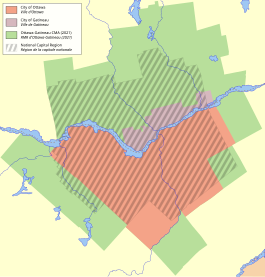
Back Rexón de la Capital Nacional (Canadá) AST National Capital Region (Kanada) German Región de la Capital Nacional (Canadá) Spanish منطقه پایتخت ملی (کانادا) Persian Région de la capitale nationale French Regija nacionalne prijestolnice Croatian Região da Capital Nacional (Canadá) Portuguese Национальный столичный регион (Канада) Russian National Capital Region (Canada) SIMPLE Національний столичний регіон (Канада) Ukrainian
National Capital Region
Région de la capitale nationale | |
|---|---|
 | |
 National Capital Region (striped area) | |
| Coordinates: 45°35′23″N 75°50′50″W / 45.58972°N 75.84722°W[1] | |
| Country | Canada |
| Provinces | Ontario Quebec |
| Principal cities | Ottawa, ON Gatineau, QC |
| Area | |
| • Metro | 8,046.99 km2 (3,106.96 sq mi) |
| Elevation | 70–556 m (230–1,825 ft) |
| Population | |
| • Metro | 1,488,307 |
| • Metro density | 185.0/km2 (479/sq mi) |
| GDP | |
| • Ottawa–Gatineau CMA | CA$ 89.9 billion (2020)[3] |
| Time zone | UTC-5 (EST) |
| • Summer (DST) | UTC-4 (EDT) |
| Area code(s) | 343, 468, 613, 753, 819, 873[4] |
The National Capital Region (NCR) (French: Région de la capitale nationale, pronounced [ʁeʒjɔ̃ də la kapital nasjɔnal]), also known as Canada's Capital Region and Ottawa–Gatineau, is an official federal designation encompassing the Canadian capital of Ottawa, Ontario, the adjacent city of Gatineau, Quebec, and surrounding suburban and exurban areas. Despite its designation, the NCR is not a separate political or administrative entity and falls within the provinces of Ontario and Quebec.
Defined by the National Capital Act (1985), the NCR covers an area of 4,715 km2 (1,820 sq mi), straddling the Ottawa River, which serves as the boundary between Ontario and Quebec. This area is smaller than the Ottawa–Gatineau census metropolitan area (CMA), which spans 8,046.99 km2 (3,106.96 sq mi). Ottawa–Gatineau is the only CMA in Canada that crosses provincial boundaries.[5][6][7]
- ^ "National Capital Region". Geographical Names Data Base. Natural Resources Canada.
- ^ a b "Census Profile, 2021 Census of Population: Ottawa - Gatineau [Census metropolitan area]". Statistics Canada. February 1, 2023. Retrieved November 18, 2023.
- ^ "Statistics Canada. Table 36-10-0468-01 Gross domestic product (GDP) at basic prices, by census metropolitan area (CMA) (x 1,000,000)". Statistics Canada.
- ^ "Telecom Decision CRTC 2008-89". Crtc.gc.ca. September 10, 2008. Retrieved August 20, 2010.
- ^ "National Capital Act (Consolidated federal laws of Canada)". Justice Canada. September 30, 2013. Retrieved March 15, 2024.
- ^ "Creating Plans". National Capital Commission. Archived from the original on August 18, 2013. Retrieved March 15, 2024.
- ^ "Focus on Geography Series, 2021 Census of Population: Ottawa-Gatineau, Census metropolitan area". Statistics Canada. December 16, 2022. Retrieved March 15, 2024.